A visit to the world-renowned Monterey Bay Aquarium is a must-do anytime you are on California‘s central coast. With breathtaking views of the Monterey Bay, cutting-edge conservation practices and technology, and educational exhibits, there is something for everyone to see and enjoy at this aquarium. Widely considered one of the best in the United States, it is famous for its emphasis on sustainable practices that allow wildlife to survive and thrive in the ocean environment while also taking measures to help vulnerable and endangered species. Here are some of the most amazing animals that you can see when you stop by the Monterey Bay Aquarium.
#1 Sea Otters
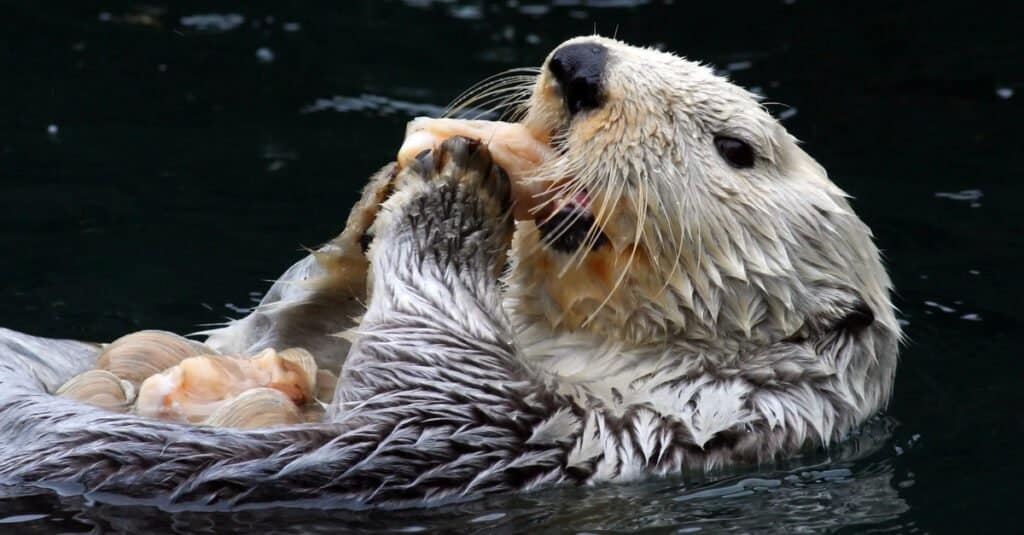
The clever otter employs objects such as stones to crack open mollusks and other food.
©Kirsten Wahlquist/Shutterstock.com
These adorable otters are the unofficial mascots of the Monterey Bay Aquarium. Five females live permanently at the aquarium due to factors that make it unsafe to release them back into the wild. They serve as surrogate mothers for young pups that are found and need to be rescued. This rescue and rehabilitation focus is one of the things that makes Monterey Bay Aquarium so special.
Typically, only two of the ladies are on exhibit at one time. The others are hard at work mothering behind the scenes. The aquarium provides frequent updates, however. These include how the rescued otters are doing, milestones that they reach as they grow, and coverage of their big returns to the wild. The aquarium also provides plenty of enrichment. During planned otter feedings, visitors can see the toys and tools that the keepers use as well as learn more about this process.
#2 Green Turtle
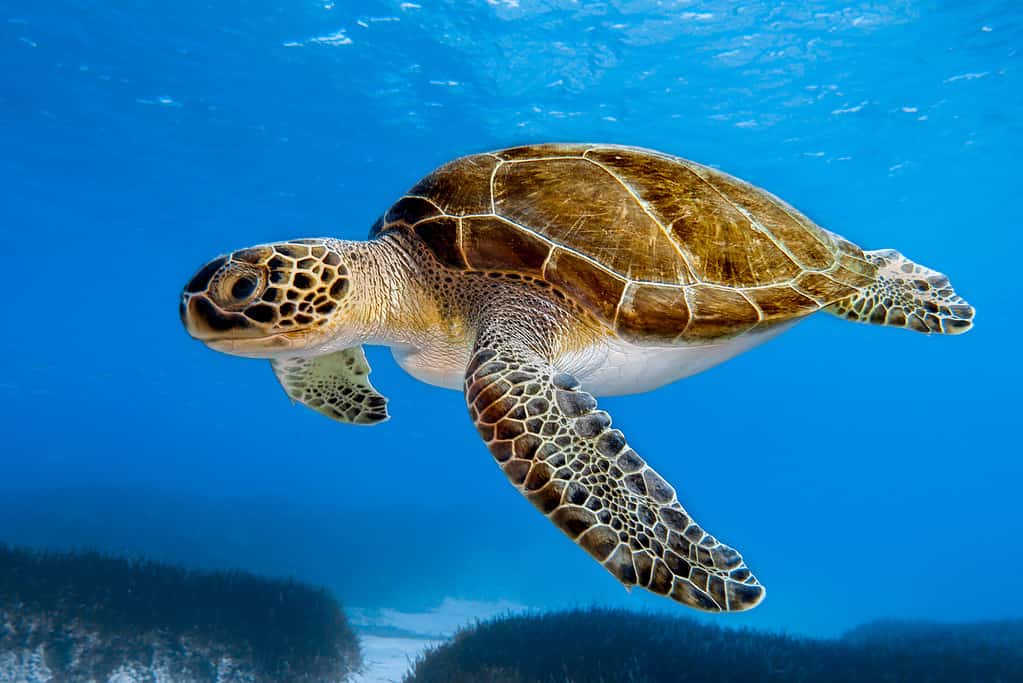
Green sea turtles don’t have green shells.
©Sakis Lazarides/ via Getty Images
These giant animals glide serenely through the Open Sea exhibit at the aquarium. This 1.2 million gallon tank houses many species that live together. Green sea turtles grow up to 400 pounds and there are usually one or two swimming around inside the exhibit on most days. They are periodically removed from the tank and relocated to a special area where they can take “sun baths.” This is necessary for turtles’ health. Fortunately, the aquarium shows behind-the-scenes videos of these turtles basking in the sun to keep visitors up-to-date on their movements and show how they take care of these animals.
Taking in the Open Sea exhibit is truly something spectacular. It stands more than twice as tall as most people. There is a wide open area in front of the exhibit and you can also walk right up to the glass. Multiple times each day, keepers provide educational narrations and question-and-answer sessions to help visitors learn more. If you are able to visit during a feeding, you’ll be able to see how these animals interact with each other.
#3 Jellyfish
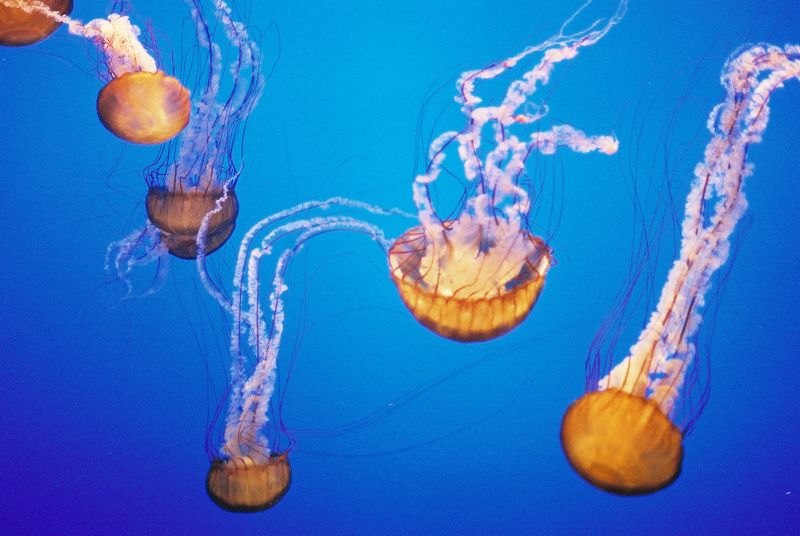
Jellyfish (Chrysaora quinquecirrha) are one of many species in the Monterey Bay Aquarium.
The aquarium is home to many species of jellyfish as well as a phenomenal exhibit that immerses visitors in the otherworldly underwater environment where they live. Soft music, backlighting, and large tanks combine to create a truly amazing effect. Watch as the jellyfish glide effortlessly in front of you. One of the great aspects of seeing jellyfish at the aquarium is that you can get close to the tanks to really study how they move and live without having to worry about getting stung. If you’ve ever wanted to learn more about jellyfish, this is your chance.
Some of the most popular species on exhibit include black sea nettles, bloodybelly comb jellies, box jellies, cross jellies, egg yolk jellies, crystal jellies, lion’s mane jellies, moon jellies, and Pacific sea nettles. There are many species to see. Fortunately, most are located near each other. This makes it even easier to see the wide array of features among these related species.
#4 Pacific Sardine
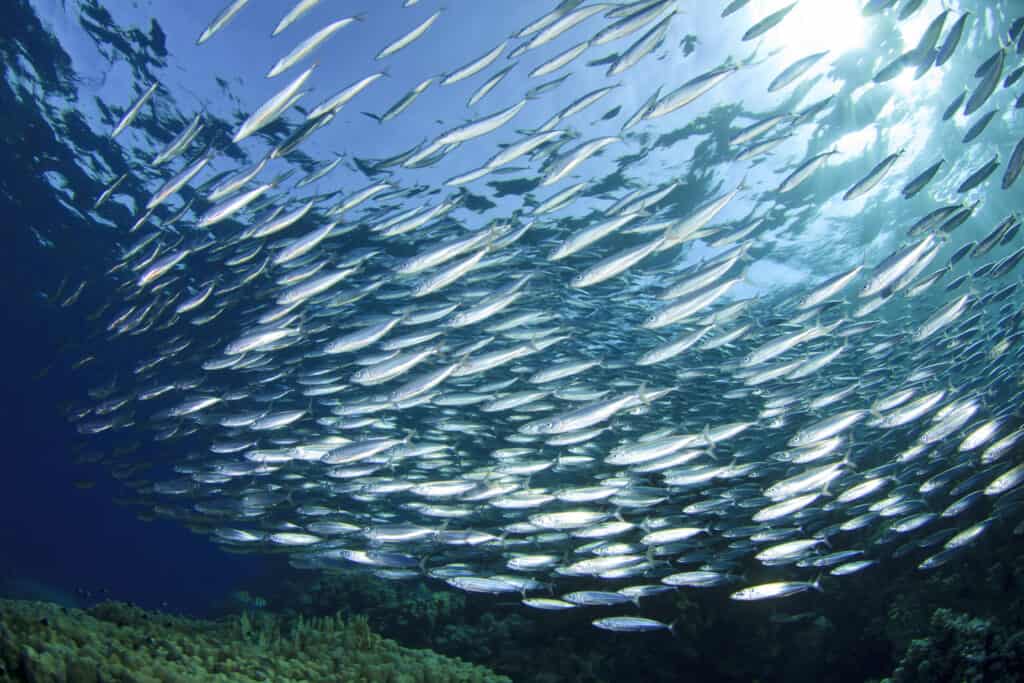
Sardines swim in large schools, which makes them fun to watch at the aquarium.
©iStock.com/richcarey
The sardine exhibit at the aquarium is fun to watch. These schooling fish travel around a tank as part of the Open Sea exhibit. As you walk in, marvel at the synchronized movements of hundreds and hundreds of sardines, all moving as one. During feedings, this school swims up from the bottom of the tank as a singular unit, one of the best ways to observe their school behavior first-hand.
In the wild, these fish range from Alaska all the way to Baja California. At one point, canning these fish and others like them was a booming industry in California, especially in Monterey. In fact, the aquarium is housed in a former cannery on a street called Cannery Row. It is really amazing to see the aquarium’s conservation and education efforts in action in the same space where these fish used to be canned for consumption.
#5 Giant Pacific Octopus

Giant Pacific octopuses are often reddish-pink in color, although they can change color to help them blend into their environment.
©karen crewe/Shutterstock.com
This is one of the most popular animals to visit at the aquarium so expect to see a crowd gathered around the octopus’ tank, especially when the guy is very active. The octopus at the aquarium likes to spend his time pressed against the glass and you can often get a great view of his tentacles. The Giant Pacific Octopus is the largest octopus species. They can get more than 13 feet long from the tip of one tentacle to the opposite one. It does change color but is often red or pink.
These animals are solitary so the octopus at the aquarium lives on its own in a special tank. Smaller sea creatures live alongside it, such as sea urchins and sea cucumbers. But there is only one octopus and he is sure a sight to behold. When the octopus is active and moving around its tank, visitors love to line up to get a quick photo or video of this large marine animal in motion.
#6 Giant Sea Bass

Giant Sea Bass, also known as the goliath
grouper
, in an aquarium. These types of rare fish prefer to live in shallow water close to coastlines.
©eril Victory/Shutterstock.com
This is a popular fish to eat, which makes the Monterey Bay Aquarium pay special attention to it. The aquarium’s seafood watch program classifies various fish by their overall sustainability, making recommendations for alternatives that are just as tasty and more sustainably caught and harvested. You can even get a helpful pocket guide for free when you visit.
This giant fish grows up to 7.5 feet and can weigh more than 500 pounds. You can see them in the Kelp Forest exhibit as well as the Monterey Bay Habitat area since they are native to this part of the ocean. They are impressive for their large size but are also slow-moving fish that are fun to watch. When you visit these exhibits, look for the giant sea bass peeking out from behind a strand of giant kelp.
#7 Scalloped Hammerhead Shark

Scalloped
hammerhead sharks
have ridges on the front of their heads.
©Ian Scott/Shutterstock.com
This shark can be seen in the Open Sea exhibit. They are easy to spot due to their size, often up to 14 feet long, and their hammer-shaped heads. The scalloped hammerhead has distinctive ridges on the front of its head that give it its name. Some populations of these sharks are considered endangered, according to the National Oceanic and Atmospheric Administration. This includes both the Eastern Pacific and Eastern Atlantic populations. The Central and Southwest Atlantic and the Indo-West Pacific populations are considered threatened.
When you spot a hammerhead shark swimming out of the darkness of the vast Open Sea exhibit, it can be very thrilling. This exhibit allows you to go all the way up to the wall of glass so it’s possible to get quite close if the shark swims near the glass. During feedings, keepers are quick to warn visitors that they might get to witness the magic of nature and the circle of life in person. Other fish in the exhibit make tasty snacks for sharks occasionally. While the aquarium feeds them a careful diet, these sharks are still natural predators and will eat additional fish if they are hungry.
#8 Yellowfin Tuna
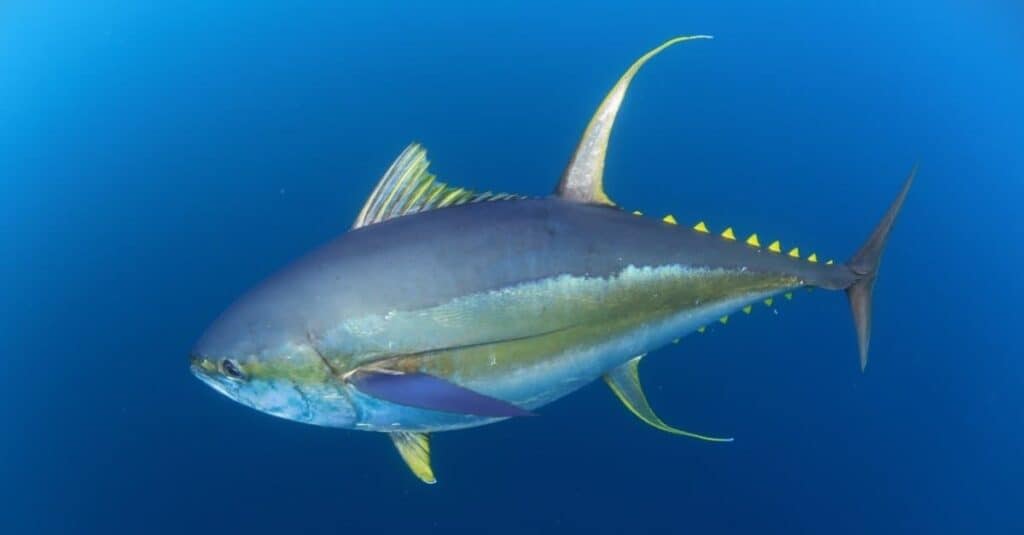
The average yellowfin tuna weighs 180 pounds but can get much larger.
©Al McGlashan/Shutterstock.com
Another Open Sea exhibit resident, the yellowfin tuna is notable both for its size as well as its role in seafood cuisine. These giant fish can get up to 4.5 feet long and around 450 pounds. They are constantly in motion and don’t stop swimming. This helps them maintain a body temperature that is actually higher than their environment. They have yellow sides, which give them their name. While the bluefin tuna is the largest tuna species, yellowfin can also get very large. They are a popular fish for deep sea fishing.
The aquarium works hard to evaluate the sustainability of various seafood choices and suggest alternatives if needed. They publish pocket guides for national seafood options, region-specific species, and a sushi guide. They do have some available in Spanish as well. If you visit the aquarium, you can pick up these pocket guides at special stations around the exhibits. From home, they are easy to download and keep as a reference.
#9 Western Snowy Plover
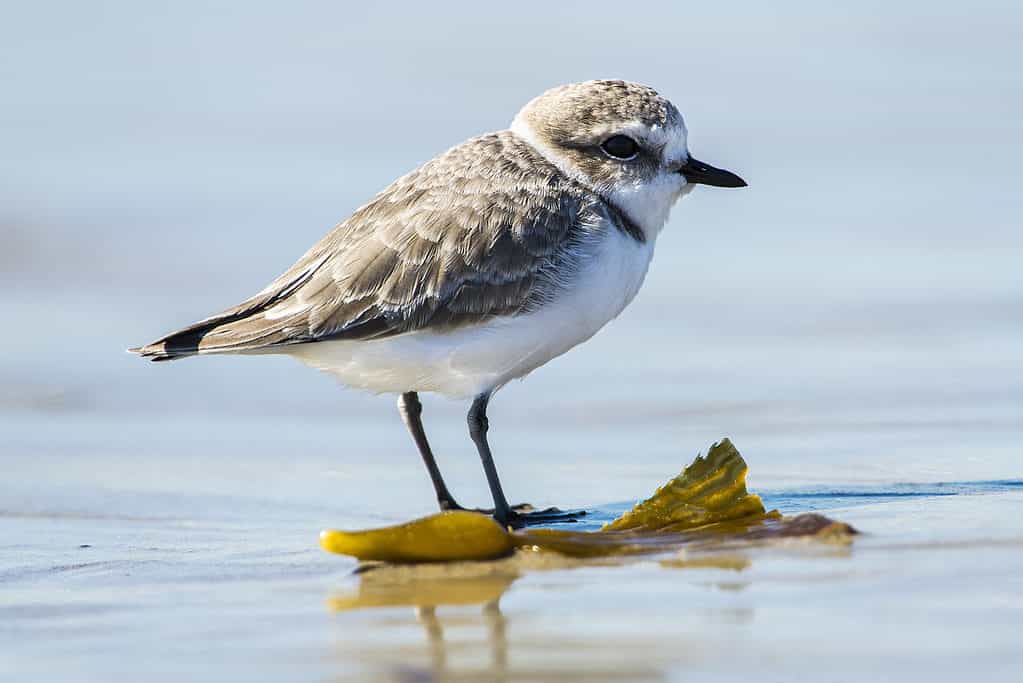
Snowy Plover (
Charadrius nivosus) in winter plumage near seaweed at San Onofre State Beach, San Diego County, Southern California.
©iStock.com/drferry
The Monterey Bay Aquarium has a small aviary that features many birds and other animals and plants that live on the shores of the bay and surrounding areas. The Western snowy plover lives all along the west coast, from Washington down to Baja California in Mexico. They can also be found on the Gulf Coast and even parts of South America and inland North America.
In the wild, plovers blend in well with their sandy environment. They are sand-colored on their backs and quite small, typically around 6 or 7 inches. Their eggs are particularly vulnerable and the aquarium has led the effort to rescue and rehabilitate these birds. When they rescue abandoned eggs, the staff incubates them and relies on adult plovers at the aquarium to raise the chicks until they are ready to be released back into the wild. Before releasing the birds, they band them so that they can continue to study them and keep track of their survival. According to the aquarium, their program has resulted in the successful release of over 150 plovers back into the wild. You can walk through the aviary to see these birds and others.
#10 Humpback Whale
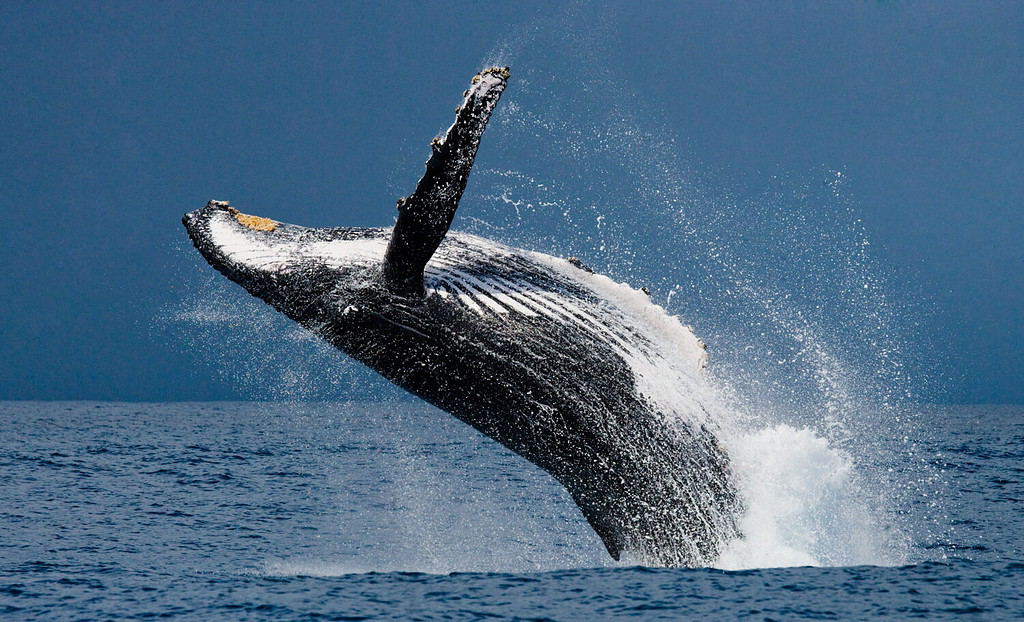
Humpback whales can be seen breaching in the waters of Monterey Bay during the summer.
©GUDKOV ANDREY/Shutterstock.com
While the Monterey Bay Aquarium doesn’t house humpback whales, they do have viewing platforms to see these and other whales that frequent the Monterey Bay. They like to breach, hurling themselves out of the water, to the delight of people looking on. Lifting their tails out of the water, also known as fluking, is also common humpback whale behavior. It’s likely that they do this as a form of communication. They are seen in Monterey Bay every summer when they feed before making their migration south.
From the aquarium’s outside area, you can often spot blue whales, dolphins, gray whales, sperm whales, and orcas. There is almost always a group of California sea lions as well as harbor seals on nearby beaches. Much of the aquarium’s work is done outside of the tanks and facilities that visitors see. Researchers and conservationists frequently go into the water of the bay to take samples, study wildlife, rescue, and rehabilitate. The viewing deck is a great place to take in one of the most breathtaking “exhibits” at the aquarium, the bay itself.
#11 Clownfish

Clownfish
provide nutrients to sea anemones while enjoying protection from predators from the anemone.
©Alex Stemmers/Shutterstock.com
These adorable fish are one of the most popular fish in the aquarium, especially with young visitors. Cries of “Nemo” and “Dory” can be heard as you approach the small tank with these tropical fish. Fortunately, it is located near the interactive kids’ area as well. These fish live in anemones, which is amazing since anemones sting many underwater species. In fact, this symbiotic relationship is a great example that keepers use to teach visitors about the way that various ocean animals interact and live together.
#12 Giant Kelp

Underwater kelp forests are home to many species in the Monterey Bay.
©iStock.com/Shur_ca
Okay, this one is a plant. But the Kelp Forest exhibit at the Monterey Bay Aquarium is so spectacular that this species gets its own shoutout on our list. Giant kelp is a fixture in Monterey Bay and one of the reasons that it is home to so many species of fish and other ocean life. The two-floor Kelp Forest exhibit allows you to see what these underwater forests look like and how the various fish, anemones, crabs, sea stars, and so many others interact. You can go from seeing the Kelp Forest exhibit inside the aquarium to observing it in the wild on the nearby observation deck. Kelp is also one of the places that sea otters like to go, which gives it another special tie to the central California coast.
| Number | Species | Where to See |
| 1 | Sea Otter | Sea Otter Exhibit |
| 2 | Green Turtle | Open Sea |
| 3 | Jellyfish | Open Sea |
| 4 | Pacific Sardine | Open Sea |
| 5 | Giant Pacific Octopus | Octopus Tank |
| 6 | Giant Sea Bass | Monterey Bay Habitat |
| 7 | Scalloped Hammerhead Shark | Open Sea |
| 8 | Yellowfin Tuna | Open Sea |
| 9 | Western Snowy Plover | Aviary |
| 10 | Humpback Whale | Monterey Bay Viewing Deck |
| 11 | Clownfish | Splash Zone |
| 12 | Giant Kelp | Kelp Forest |
The photo featured at the top of this post is © iStock.com/santalechuga
Thank you for reading! Have some feedback for us? Contact the AZ Animals editorial team.






